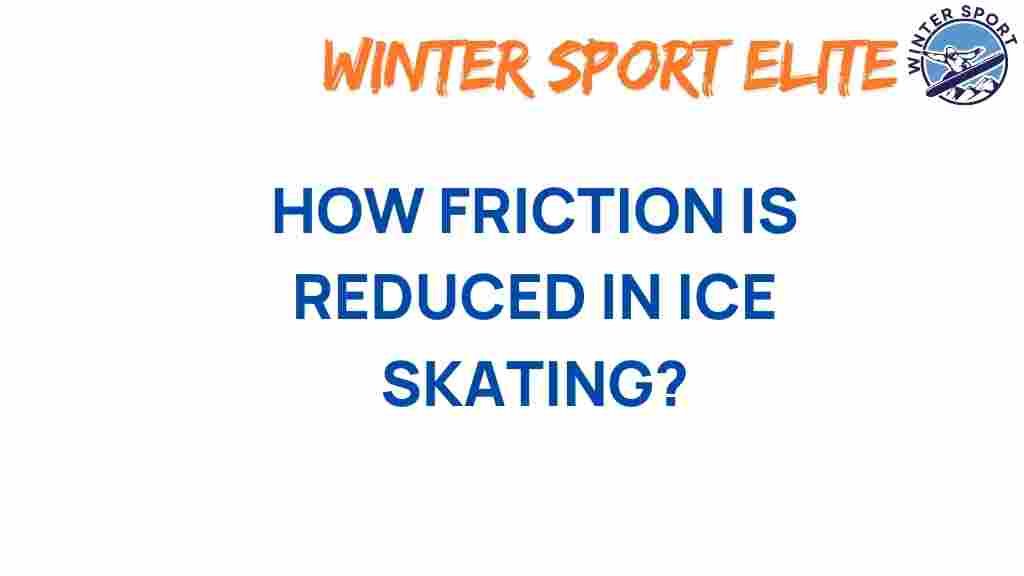Unveiling the Secrets: How Friction is Reduced in Ice Skating
Ice skating is a sport that combines grace, speed, and skill, captivating audiences and athletes alike. One of the key factors that enhance performance in ice skating is the reduction of friction between the skate blades and the ice surface. Understanding how friction is minimized can significantly improve glide efficiency and overall skating techniques. In this article, we will explore the physics of skating, delve into effective performance enhancement strategies, and discuss athlete training to master the art of ice skating.
The Physics of Ice Skating
To fully appreciate the process of friction reduction in ice skating, it’s essential to understand the physics at play. When a skater glides across the ice, the interaction between the skate blade and the ice surface is crucial. Here are some fundamental concepts involved:
- Pressure and Melting: Skate blades apply pressure on the ice, causing a thin layer of water to form. This layer reduces friction and allows for smoother movement.
- Blade Design: The shape and sharpness of the skate blade influence how it interacts with the ice. A well-maintained blade minimizes drag and maximizes glide efficiency.
- Temperature and Ice Quality: The temperature of the ice and its surface quality affect friction. Colder ice creates less water, leading to higher friction, whereas warmer ice allows for better glide.
The Importance of Glide Efficiency
Glide efficiency is a term that describes how effectively a skater moves across the ice. Higher glide efficiency means less energy is expended for greater speed. To achieve this, skaters must focus on several factors:
- Body Position: Maintaining a low center of gravity and proper posture can significantly improve glide efficiency.
- Push Technique: The way a skater pushes off from the ice can either increase or reduce friction. A powerful yet controlled push is key.
- Weight Distribution: Proper weight distribution over the skate blades can enhance balance and reduce unnecessary friction.
Skating Techniques for Friction Reduction
Mastering specific skating techniques can lead to effective friction reduction. Here are some essential techniques that every skater should practice:
1. Edging
Using the edges of the skate blades effectively allows skaters to control their movements better and reduce friction. Proper edging techniques involve:
- Leaning into turns to engage the blade’s edges.
- Maintaining consistent pressure on the edges during glides.
- Practicing transitions between inside and outside edges for smoother movement.
2. Crossovers
Crossovers are crucial for building speed and maintaining momentum. To execute a crossover effectively:
- Shift weight from one foot to the other seamlessly.
- Keep your knees bent and body low for optimal balance.
- Use a strong push from the outside foot to propel forward.
3. Swizzles and Stroking
These foundational techniques help skaters develop their glide and balance. Here’s how to improve them:
- Practice swizzles in a straight line to build confidence.
- Focus on long, smooth strokes while maintaining a relaxed upper body.
- Gradually increase speed while keeping the technique precise.
Enhancing Performance Through Training
Training is an integral part of becoming a proficient ice skater. Here are some tips for athlete training that focus on reducing friction and enhancing performance:
- Strength Training: Building strength in the legs, core, and upper body can improve push-off power and balance.
- Flexibility Exercises: Enhancing flexibility through stretching can help skaters achieve better body positions and reduce injury risk.
- Endurance Training: Incorporating cardiovascular exercises into training routines will help skaters maintain high energy levels during performances.
Common Troubleshooting Tips
Even the most skilled skaters can encounter issues with friction during their performance. Here are some common troubleshooting tips:
- Blade Maintenance: Regularly sharpen and maintain skate blades to ensure optimal performance. Dull blades increase friction and reduce glide efficiency.
- Ice Surface Condition: Always check the ice surface for imperfections. Ruts and grooves can dramatically impact friction levels. If necessary, inform rink management to address the issue.
- Skating Technique Review: Work with a coach to review and refine your skating techniques. Small adjustments can lead to significant improvements in glide efficiency.
Conclusion
Reducing friction in ice skating is a combination of understanding the physics involved, mastering effective skating techniques, and engaging in rigorous athlete training. By focusing on glide efficiency and performance enhancement strategies, skaters can improve their skills and enjoy the sport even more. Remember, every skater can benefit from continual learning and practice. For more insights and resources on ice skating, consider exploring this comprehensive guide.
As you embark on your ice skating journey, keep these principles in mind, and watch your performance soar as you glide effortlessly across the ice!
For further information about the science behind ice skating, check out this external resource.
This article is in the category Training and created by WinterSportElite Team
